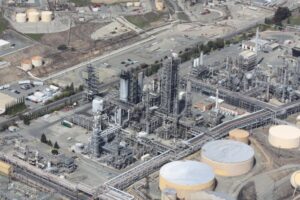
The price of gas is beginning its annual rise to take advantage of summer travel plans. Today the average price at the pump is $3.668 per gallon, according to the Automobile Association of America (AAA).
The current price of gas is 11 cents higher than last week. However, it is 42 cents lower than this time last year. In addition, it is well below the record high of $5.016 per gallon set last June.
That said, several pieces are in play that could push the price of gas higher. Consequently, the U. S. Energy Information Agency (EIA) is predicting the price of gas will top out at $3.60 to $3.70 a gallon this summer.
Supply and Demand Out of Whack
Among the things that are askew in the current rise in gas prices is the law of supply and demand.
That Axum of economics says that if demand drops and supplies stay about the same – the price of gas should decline. However, according to the EIA, demand for gas fell from 9.3 to 8.94 million barrels a day as prices rose last week.
The reason gas prices violated the law of supply and demand is a recent rise in oil prices. Oil is the main ingredient in gasoline.
OPEC+ Cuts
Oil prices were given a boost earlier this month when OPEC+ announced it will begin cutting oil production by 1.16 million barrels per day in May. However, oil prices have risen every day since March 29, according to the AAA.
OPEC+ is a combination of 13 OPEC countries located primarily in the Middle East and Africa and another 10 oil-producing nations.
Oil rose again Friday following the release of the latest Oil Markets Report from the International Energy Agency (IEA). Demand for oil will climb by two million barrels a day to a record 101.9 barrels a day, according to the report.
Much of that increased demand is expected to come from China.
Chinese Demand
The world’s second-largest economy has been shackled by extended covid lockdowns. However, recently the government has lifted restrictions. As a result, the IEA says oil demand will be “buoyed by a resurgent China”. It expects China to account for 90 percent of the growth in oil demand.
However, there are headwinds for the Chinese economy that may affect its thurst for oil.
The International Monetary Fund (IMF) expects the nation’s economy to grow 5.2 percent this year. That is an increase over 2022’s three percent. However, it is a far cry from the 8.4 percent experienced in 2021.
Long-term, the IMF notes, the Chinese economy is hampered by low productivity and an aging population.
U. S Refineries
In addition to foreign influences, there is a domestic component pushing the price of gas.
U. S. refineries routinely shut down or reduce production in the Spring to clean and perform maintenance. As part of that maintenance, refineries switch from winter to more expensive summer gas.
The difference between the gas our vehicles use in winter versus summer is measured by the Reid Vapor Pressure (RVP). The RVP measures how quickly fuel evaporates or is released into the air to create pollution.
Warm summer months make it easier for gasoline to evaporate. As a result, summer gas must have a lower RVP than winter gas. That makes summer gas more expensive to produce. As a result, the price of gas usually rises with the temperature.
In addition, gasoline stockpiles have fallen as a result of the U. S. oil refineries’ seasonal transition. Even so, the EIA expects production to speed past demand and replenish gasoline reserves. As a result, prices are expected to stabilize in the coming months.
Read More:
Come back to what you love! Dollardig.com is the most reliable cash-back site on the web. Just sign up, click, shop, and get full cashback!